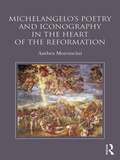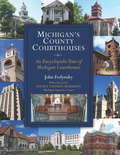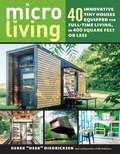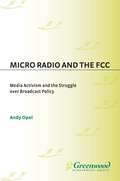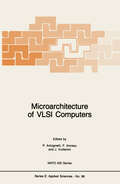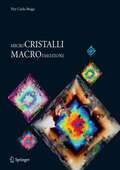- Table View
- List View
Michelangelo's Finger: An Exploration of Everyday Transcendence
by Raymond TallisRaymond Tallis is a renowned polymath: he was listed by the Independent in 2007 as one of fifty 'Brains of Britain' and in 2004 Prospect magazine voted him one of Britain's top public intellectual.In this startlingly original and persuasive book, Raymond Tallis shows that it is easy to underestimate the influence of small things in determining what manner of creatures humans are. He reveals that over time the repeated and multiple effects of the seemingly insignificant can make an enormous difference and argues that the independent movement of the human index finger is one such easily overlooked factor. Indeed, not for nothing is the index finger called 'the forefinger'. It is the one we most naturally deploy when we want to winkle things out of small spaces, but it plays a far more significant role in an action unique to us among primates: pointing. In Michelangelo's Finger, Raymond Tallis argues that it is through pointing that the index finger made a significant contribution to hominid development and to the creation of a human world separate to the rest of the natural world. Observing the ceiling of the Sistine Chapel and the hugely familiar and awkward encounter between Michelangelo's God and Man through their index fingers, Tallis identifies an intuitive indication of the central role of the index finger in making us unique. Just as the reaching index fingers of God and Man are here made central to the creation of our kind, so Tallis believes that the simple act of pointing is central to our extraordinary evolution.
Michelangelos Kruzifixus für Vittoria Colonna: Bemerkungen zu Ikonographie und theologischer Deutung (Wissenschaftliche Abhandlungen der Rheinisch-Westfälischen Akademie der Wissenschaften #44)
by Reiner HaussherrMichelangelo's Notebooks: The Drawing, Notes, Poetry, and Letters of the Great Master (Notebook Series)
by Carolyn VaughanMichelangelo's Notebooks is an intimate celebration of the artist's sketches, architectural drawings, letters, and love poems.Michelangelo Buonarroti is considered to be one of the greatest artists of the sixteenth century, not only in painting but in writing and poetry as well. He filled hundreds of sheets of paper with exquisite drawings, many of which would eventually become some of the most celebrated masterpieces of all time, and he wrote over 300 poems and sonnets on admiration and spirituality. Organized chronologically, Michelangelo's Notebooks is an illustrated record of the artist's life and work, and combines the artists's own words with his sketches and finished compositions. His letters about the Sistine Chapel and Pope Julius, for example, are illustrated with sketches that he produced while he was writing. Edited and curated by Carolyn Vaughan, former editor at the Metropolitan Museum of Art, she provides fascinating commentary and insights into the material presented throughout the book.
Michelangelo's Notebooks: The Drawing, Notes, Poetry, and Letters of the Great Master (Notebook Series)
by Carolyn VaughanMichelangelo's Notebooks is an intimate celebration of the artist's sketches, architectural drawings, letters, and love poems. Michelangelo Buonarroti is considered to be one of the greatest artists of the sixteenth century, not only in painting but in writing and poetry as well. He filled hundreds of sheets of paper with exquisite drawings, many of which would eventually become some of the most celebrated masterpieces of all time, and he wrote over 300 poems and sonnets on admiration and spirituality. Organized chronologically, Michelangelo's Notebooks is an illustrated record of the artist's life and work, and combines the artists's own words with his sketches and finished compositions. His letters about the Sistine Chapel and Pope Julius, for example, are illustrated with sketches that he produced while he was writing. Edited and curated by Carolyn Vaughan, former editor at the Metropolitan Museum of Art, she provides fascinating commentary and insights into the material presented throughout the book.
Michelangelo's Painting: Selected Essays (Essays by Leo Steinberg)
by Leo SteinbergLeo Steinberg was one of the most original art historians of the twentieth century, known for taking interpretive risks that challenged the profession by overturning reigning orthodoxies. In essays and lectures ranging from old masters to contemporary art, he combined scholarly erudition with an eloquent prose that illuminated his subject and a credo that privileged the visual evidence of the image over the literature written about it. His writings, sometimes provocative and controversial, remain vital and influential reading. For half a century, Steinberg delved into Michelangelo’s work, revealing the symbolic structures underlying the artist’s highly charged idiom. This volume of essays and unpublished lectures elucidates many of Michelangelo’s paintings, from frescoes in the Sistine Chapel to the Conversion of St. Paul and the Crucifixion of St. Peter, the artist’s lesser-known works in the Vatican’s Pauline Chapel; also included is a study of the relationship of the Doni Madonna to Leonardo. Steinberg’s perceptions evolved from long, hard looking. Almost everything he wrote included passages of old-fashioned formal analysis, but always put into the service of interpretation. He understood that Michelangelo’s rendering of figures, as well as their gestures and interrelations, conveys an emblematic significance masquerading under the guise of naturalism. Michelangelo pushed Renaissance naturalism into the furthest reaches of metaphor, using the language of the body to express fundamental Christian tenets once expressible only by poets and preachers. Michelangelo’s Painting is the second volume in a series that presents Steinberg’s writings, selected and edited by his longtime associate Sheila Schwartz.
Michelangelo's Painting: Selected Essays (Essays by Leo Steinberg)
by Leo SteinbergLeo Steinberg was one of the most original art historians of the twentieth century, known for taking interpretive risks that challenged the profession by overturning reigning orthodoxies. In essays and lectures ranging from old masters to contemporary art, he combined scholarly erudition with an eloquent prose that illuminated his subject and a credo that privileged the visual evidence of the image over the literature written about it. His writings, sometimes provocative and controversial, remain vital and influential reading. For half a century, Steinberg delved into Michelangelo’s work, revealing the symbolic structures underlying the artist’s highly charged idiom. This volume of essays and unpublished lectures elucidates many of Michelangelo’s paintings, from frescoes in the Sistine Chapel to the Conversion of St. Paul and the Crucifixion of St. Peter, the artist’s lesser-known works in the Vatican’s Pauline Chapel; also included is a study of the relationship of the Doni Madonna to Leonardo. Steinberg’s perceptions evolved from long, hard looking. Almost everything he wrote included passages of old-fashioned formal analysis, but always put into the service of interpretation. He understood that Michelangelo’s rendering of figures, as well as their gestures and interrelations, conveys an emblematic significance masquerading under the guise of naturalism. Michelangelo pushed Renaissance naturalism into the furthest reaches of metaphor, using the language of the body to express fundamental Christian tenets once expressible only by poets and preachers. Michelangelo’s Painting is the second volume in a series that presents Steinberg’s writings, selected and edited by his longtime associate Sheila Schwartz.
Michelangelo's Poetry and Iconography in the Heart of the Reformation
by Ambra MoronciniContextualizing Michelangelo’s poetry and spirituality within the framework of the religious Zeitgeist of his era, this study investigates his poetic production to shed new light on the artist’s religious beliefs and unique language of art. Author Ambra Moroncini looks first and foremost at Michelangelo the poet and proposes a thought-provoking reading of Michelangelo’s most controversial artistic production between 1536 and c.1550: The Last Judgment, his devotional drawings made for Vittoria Colonna, and his last frescoes for the Pauline Chapel. Using theological and literary analyses which draw upon reformist and Protestant scriptural writings, as well as on Michelangelo’s own rime spirituali and Vittoria Colonna’s spiritual lyrics, Moroncini proposes a compelling argument for the impact that the Reformation had on one of the greatest minds of the Italian Renaissance. It brings to light how, in the second quarter of the sixteenth century in Italy, Michelangelo’s poetry and aesthetic conception were strongly inspired by the revived theologia crucis of evangelical spirituality, rather than by the theologia gloriae of Catholic teaching.
Michelangelo's Poetry and Iconography in the Heart of the Reformation
by Ambra MoronciniContextualizing Michelangelo’s poetry and spirituality within the framework of the religious Zeitgeist of his era, this study investigates his poetic production to shed new light on the artist’s religious beliefs and unique language of art. Author Ambra Moroncini looks first and foremost at Michelangelo the poet and proposes a thought-provoking reading of Michelangelo’s most controversial artistic production between 1536 and c.1550: The Last Judgment, his devotional drawings made for Vittoria Colonna, and his last frescoes for the Pauline Chapel. Using theological and literary analyses which draw upon reformist and Protestant scriptural writings, as well as on Michelangelo’s own rime spirituali and Vittoria Colonna’s spiritual lyrics, Moroncini proposes a compelling argument for the impact that the Reformation had on one of the greatest minds of the Italian Renaissance. It brings to light how, in the second quarter of the sixteenth century in Italy, Michelangelo’s poetry and aesthetic conception were strongly inspired by the revived theologia crucis of evangelical spirituality, rather than by the theologia gloriae of Catholic teaching.
Michelangelo’s Sculpture: Selected Essays (Essays by Leo Steinberg)
by Leo SteinbergLeo Steinberg was one of the most original and daring art historians of the twentieth century, known for taking interpretative risks that challenged the profession by overturning reigning orthodoxies. In essays and lectures that ranged from old masters to contemporary art, he combined scholarly erudition with an eloquent prose that illuminated his subject and a credo that privileged the visual evidence of the image over the literature written about it. His works, sometimes provocative and controversial, remain vital and influential reading. For half a century, Steinberg delved into Michelangelo’s work, revealing the symbolic structures underlying the artist’s highly charged idiom. This volume of essays and unpublished lectures explicates many of Michelangelo’s most celebrated sculptures, applying principles gleaned from long, hard looking. Almost everything Steinberg wrote included passages of old-fashioned formal analysis, but here put to the service of interpretation. He understood that Michelangelo’s rendering of figures as well as their gestures and interrelations conveys an emblematic significance masquerading under the guise of naturalism. Michelangelo pushed Renaissance naturalism into the furthest reaches of metaphor, using the language of the body and its actions to express fundamental Christian tenets once expressible only by poets and preachers—or, as Steinberg put it, in Michelangelo’s art, “anatomy becomes theology.” Michelangelo’s Sculpture is the first in a series of volumes of Steinberg’s selected writings and unpublished lectures, edited by his longtime associate Sheila Schwartz. The volume also includes a book review debunking psychoanalytic interpretation of the master’s work, a light-hearted look at Michelangelo and the medical profession and, finally, the shortest piece Steinberg ever published.
Michelangelo’s Sculpture: Selected Essays (Essays by Leo Steinberg)
by Leo SteinbergLeo Steinberg was one of the most original and daring art historians of the twentieth century, known for taking interpretative risks that challenged the profession by overturning reigning orthodoxies. In essays and lectures that ranged from old masters to contemporary art, he combined scholarly erudition with an eloquent prose that illuminated his subject and a credo that privileged the visual evidence of the image over the literature written about it. His works, sometimes provocative and controversial, remain vital and influential reading. For half a century, Steinberg delved into Michelangelo’s work, revealing the symbolic structures underlying the artist’s highly charged idiom. This volume of essays and unpublished lectures explicates many of Michelangelo’s most celebrated sculptures, applying principles gleaned from long, hard looking. Almost everything Steinberg wrote included passages of old-fashioned formal analysis, but here put to the service of interpretation. He understood that Michelangelo’s rendering of figures as well as their gestures and interrelations conveys an emblematic significance masquerading under the guise of naturalism. Michelangelo pushed Renaissance naturalism into the furthest reaches of metaphor, using the language of the body and its actions to express fundamental Christian tenets once expressible only by poets and preachers—or, as Steinberg put it, in Michelangelo’s art, “anatomy becomes theology.” Michelangelo’s Sculpture is the first in a series of volumes of Steinberg’s selected writings and unpublished lectures, edited by his longtime associate Sheila Schwartz. The volume also includes a book review debunking psychoanalytic interpretation of the master’s work, a light-hearted look at Michelangelo and the medical profession and, finally, the shortest piece Steinberg ever published.
Michelangelo’s Vatican Pietà and its Afterlives (Routledge Research in Art History)
by Lisa M. RafanelliThis book offers a fresh perspective on Michelangelo’s well-known masterpiece, the Vatican Pietà, by tracing the shifting meaning of the work of art over time. Lisa M. Rafanelli chronicles the object history of the Vatican Pietà and the active role played by its many reproductions. The sculpture has been on continuous view for over 500 years, during which time its cultural, theological, and artistic significance has shifted. Equally important is the fact that over its long life it has been relocated numerous times and has also been reproduced in images and objects produced both during Michelangelo’s lifetime and long after, described here as artistic progeny: large-scale, unique sculpted variants, smaller-scale statuettes, plaster and bronze casts, and engraved prints. The book will be of interest to scholars working in art history, Renaissance studies, early modern studies, religion, Christianity, and theology.
Michelangelo’s Vatican Pietà and its Afterlives (Routledge Research in Art History)
by Lisa M. RafanelliThis book offers a fresh perspective on Michelangelo’s well-known masterpiece, the Vatican Pietà, by tracing the shifting meaning of the work of art over time. Lisa M. Rafanelli chronicles the object history of the Vatican Pietà and the active role played by its many reproductions. The sculpture has been on continuous view for over 500 years, during which time its cultural, theological, and artistic significance has shifted. Equally important is the fact that over its long life it has been relocated numerous times and has also been reproduced in images and objects produced both during Michelangelo’s lifetime and long after, described here as artistic progeny: large-scale, unique sculpted variants, smaller-scale statuettes, plaster and bronze casts, and engraved prints. The book will be of interest to scholars working in art history, Renaissance studies, early modern studies, religion, Christianity, and theology.
Michigan Family Farms and Farm Buildings: Landscapes of the Heart and Mind (Association For Social Anthropology In Oceania Monograph #No. 7)
by Hemalata C. Dandekar"Thoughtfully documenting the voice and emotions of many who might otherwise remain unheard, Hemalata Dandekar provides in-depth accounts and insights, underpinned by quietly rigorous analysis, about family interactions and the perceptions, understandings, and memories of family members . . . a tribute to the indomitability of the human spirit as an enduring force in sustaining farm life on the Michigan farms." ---Anatole Senkevitch, Jr., Taubman College of Architecture and Urban Planning, University of Michigan Michigan's family farms form the backbone of the state. One need only see the Centennial Farm signs that dot the sides of the state's country roads to understand that. Hemalata Dandekar shows in her new book just how connected those family farm buildings are to the families that inhabit them. Fifteen family-farm case studies display farm buildings' relationship to the land they sit on, their function on the farm, the materials they're made with, the farm enterprises themselves, and the families who own them. Photographs, plans, elevations, and sections of exemplary traditional farm buildings show the aesthetic and architectural qualities of those types of buildings across the state. The ways in which the buildings serve the productive activities of the farm, shelter and nourish the people and livestock, yield a living, and enable the aspirations of farm people are shown in the words and photographs of the farmers themselves. The buildings form a window into the lives of Michigan's family farms and into the hearts and minds of the people who have lived and worked on them their entire lives. Hemalata C. Dandekar is Department Head of City and Regional Planning at California Polytechnic State University. She specializes in urbanization, urban-rural linkages, rural development, and gender and housing. She developed her love of Michigan farmers and farm architecture during her years as a student and professor at the Urban Planning program of the A. Alfred Taubman College of Architecture and Urban Planning at the University of Michigan. She was Director of the Center for South and Southeast Asian Studies and Associate Vice President for Research at the University of Michigan.
Michigan's County Courthouses
by John Fedynsky“ Whether you are an attorney, a Michigan history buff, or a lover of architecture, you will find this book is a valuable resource.” ---Michigan Bar Journal John Fedynsky documents in narrative and photos every county courthouse of Michigan's eighty-three counties, as well as the Michigan Hall of Justice. These buildings are symbols: physically they stand, but figuratively they speak. They embody the purposes for which they were created: law, order, justice, and the promise of a better tomorrow. Fedynsky tells the story of each building. For Michigan, the typical evolution begins in the cabin, tavern, or hotel of a prominent local settler and progresses through incarnations of simple log or wooden clapboard, and then opulent stone or brick, before the structure arrives in modern and utilitarian form. But there are myriad exceptions to this rule, and they add to the diversity of Michigan's county courthouses. In Fedynsky's descriptions, verifiable facts and local lore weave together in dramatic tales of outrageous crime, courtroom intrigue, backroom dealing, jury determination, and judicial prerogative. Released jail inmates assist with evacuating and extinguishing a courthouse fire, residents during a natural disaster seek and find physical refuge behind the sure walls of the courthouse, and vigilant legions of homebound defenders are stationed in wartime throughout the courthouse towers scanning the skies for signs of foreign aircraft. Then there are the homey touches that emphasize the "house" half of Michigan's courthouses: local folks dropping off plants in the courthouse atrium to use it as a winter greenhouse, cows grazing on the public square, county fairs in or near the courthouse, and locally made artwork hanging in public hallways. The courthouses bear within their walls a richness of soul endowed by the good people who make each one special. John Fedynsky is a former research attorney for the Michigan Court of Appeals in Detroit and Grand Rapids, Michigan. He also served as a law clerk to the Honorable Robert H. Cleland, U.S. District Court for the Eastern District of Michigan. Fedynsky currently practices civil law as an Assistant Attorney General for the State of Michigan. Cover design by Heidi Dailey Cover photos: John Fedynsky
Mickey Rourke (Film Stars)
by Keri Walsh'Rebel', 'oddball' and 'Uncle Mickey': just three of the many conflicting labels Mickey Rourke has 'earned' over his remarkable career in the limelight. His public persona, moving from actor to boxer to actor, is not easy to define: making it all the more intriguing, and making Keri Walsh's study an unique and fascinating addition to the 'Film Stars' series.
Mickey Rourke (Film Stars)
by Keri Walsh'Rebel', 'oddball' and 'Uncle Mickey': just three of the many conflicting labels Mickey Rourke has 'earned' over his remarkable career in the limelight. His public persona, moving from actor to boxer to actor, is not easy to define: making it all the more intriguing, and making Keri Walsh's study an unique and fascinating addition to the 'Film Stars' series.
Micro Living: 40 Innovative Tiny Houses Equipped for Full-Time Living, in 400 Square Feet or Less
by Derek “Deek” DiedricksenLive tiny without sacrificing the comforts of home with Derek &“Deek&” Diedricksen&’s lively exploration of 40 small dwellings outfitted with features essential to full-time, year-round living — complete with floor plans, real experiences, and expert tips from tiny house residents.
Micro Radio and the FCC: Media Activism and the Struggle over Broadcast Policy (Non-ser.)
by Andrew OpelMicro Radio became a lightening rod for the emerging Media Activism and Reform Movement. Like the environmental movement in the 1960s and 70s that focused on specific issues like nuclear power, the Media Activism Movement discovered a significant formative issue in micro radio at the turn of the millennium. This book is a close examination of the struggle over micro radio. Throughout this research micro radio is viewed as a site of social activity, a unique cultural and historical bond where ideas about the relationship between media and democracy are explored. This work is the first to spotlight this emerging social movement and uses critical historical analysis to provide a description of it.The information in this book shows the struggle over micro radio as the most recent manifestation of a growing social movement, a movement of media activism and reform. As local people took to the airwaves, illegally broadcasting the frivolous to the serious, theoretical concepts such as localism and public access suddenly became grounded in a real world radio show. Micro radio broadcasters were able to demonstrate what is left out of most mainstream media. They showed what could happen when a diverse public is allowed to access the most universal telecommunications of the day. This look at micro radio will be valuable to communications students who are interested in the strategies behind media and social movements, alternative media, and news media practices.
Microalgae Building Enclosures: Design and Engineering Principles
by Kyoung Hee KimMicroalgae architecture has gained awareness for its biotechnical potential to achieve net-zero energy architecture while also promoting ecological sustainability and occupant well-being. Microalgae Building Enclosures: Design and Engineering Principles aims to provide design, engineering, and biotechnical guidelines for microalgae building enclosures that need to be considered for symbiotic relations among the built environment, humans, and ecosystems. Part I of the book introduces the theoretical background of microalgae as a bioremediator and future energy system and their potential roles toward sustainable and healthy built environments. Part II exemplifies interventions and multiple benefits of microalgae systems in product, architecture, urban, and infrastructure applications across the globe including Africa, Asia, Australia, Europe, South America, and North America. Part III explains the design and engineering criteria, biotechnical design requirements, and various performance metrics for microalgae architecture. Finally, Part IV investigates potential building applications in low-rise buildings, high-rise buildings, and energy-efficient retrofitting. The book also includes international case studies of microalgae building systems within various building types and climates. As one of the first books to comprehensively cover this emerging area of microalgae building enclosures, Microalgae Building Enclosures is an essential source for professionals and students looking to expand architectural discourse on nature integrated building systems to achieve the triple bottom line of sustainability.
Microalgae Building Enclosures: Design and Engineering Principles
by Kyoung Hee KimMicroalgae architecture has gained awareness for its biotechnical potential to achieve net-zero energy architecture while also promoting ecological sustainability and occupant well-being. Microalgae Building Enclosures: Design and Engineering Principles aims to provide design, engineering, and biotechnical guidelines for microalgae building enclosures that need to be considered for symbiotic relations among the built environment, humans, and ecosystems. Part I of the book introduces the theoretical background of microalgae as a bioremediator and future energy system and their potential roles toward sustainable and healthy built environments. Part II exemplifies interventions and multiple benefits of microalgae systems in product, architecture, urban, and infrastructure applications across the globe including Africa, Asia, Australia, Europe, South America, and North America. Part III explains the design and engineering criteria, biotechnical design requirements, and various performance metrics for microalgae architecture. Finally, Part IV investigates potential building applications in low-rise buildings, high-rise buildings, and energy-efficient retrofitting. The book also includes international case studies of microalgae building systems within various building types and climates. As one of the first books to comprehensively cover this emerging area of microalgae building enclosures, Microalgae Building Enclosures is an essential source for professionals and students looking to expand architectural discourse on nature integrated building systems to achieve the triple bottom line of sustainability.
Microanalysis in Music Therapy: Methods, Techniques and Applications for Clinicians, Researchers, Educators and Students
by Thomas Wosch and Tony WigramThe contributors to this groundbreaking book look at methods of micro process analyses used in a variety of music therapy contexts, both clinical and research-based. They outline their methods and also give examples of the practical application of microanalysis from their clinical experience.
Microarchitecture of VLSI Computers (NATO Science Series E: #96)
by P. Antognetti F. Anceau J. VuilleminProceedings of the NATO Advanced Study Institute, SOGESTA, Urbino, Italy, July 9-20, 1984
Microcomputers in Property: A surveyor's guide to Lotus 1-2-3 and dBASE IV
by O. Bevan T.J. Dixon S. HargitayThis handbook introduces surveyors to the use of microcomputers in the property industry using 'real-life' example applications with clear explanations, it will provide the surveyor with the knowledge and expertise to design spreadsheets and database management systems for use in a variety of general practice tasks from valuation to estate agency.
Microcomputers in Property: A surveyor's guide to Lotus 1-2-3 and dBASE IV
by O. Bevan T.J. Dixon S. HargitayThis handbook introduces surveyors to the use of microcomputers in the property industry using 'real-life' example applications with clear explanations, it will provide the surveyor with the knowledge and expertise to design spreadsheets and database management systems for use in a variety of general practice tasks from valuation to estate agency.
Microcristalli-macroemozioni
by Pier Carlo BragaMolte persone hanno avuto occasione di vedere le forme ed i colori dei cristalli formati dalle rocce cristalline, ma forse pochi sanno che le sostanze chimiche possono formare dei microcristalli, visibili al microscopio, con forme e colori altrettanto belli. Immersi nel nostro mondo macroscopico non ci rendiamo conto che attorno a noi vi sono altri fantastici mondi microscopici che attendono di essere svelati. In questo libro sono riportate con intento educativo una serie di informazioni di base su come preparare i microcristalli e su come poterli osservare e fotografare al microscopio, ma l’aspetto più affascinante è la vasta serie di immagini di microcristalli che viene proposta. Questo libro vuole condividere con il lettore le emozioni visive che vengono da un incredibile fusione di forme con un arcobaleno di variazioni cromatiche e di impareggiabile bellezza, che non sono solo un piacere per gli occhi, ma testimoniano anche come la fantasia della natura non abbia mai fine.




